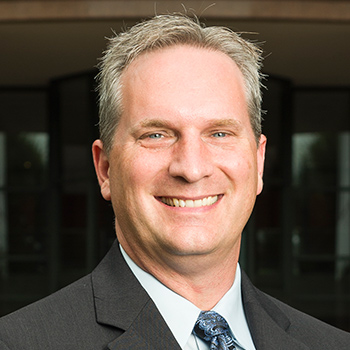Leading the ‘retirement two-step’

Bart Spachek, ChFEBC • Overland Park, KS
Reign Benefits Consulting • Cornerstone Securities LLC
Read full biography below
Combining a retirement plan’s self-directed investment option with professionally managed active strategies creates an entirely new dynamic.
Proactive Advisor Magazine: Bart, explain the core focus of your practice.
I have a very consistent message to potential clients that I call the “retirement two-step.” I work primarily with individuals and their retirement plans, whether they are government employees; in an educational, health-care, or charitable nonprofit organizations; or work at a for-profit large company.
One of the growing trends in our industry is the availability of self-directed investment options within retirement plans. Most people are not aware of this and believe their only viable investment choices are within the usually limited menu of funds offered by their plan. My “two-step” message is that they can take more control over their retirement planning and investments and combine a self-directed option with professional active money management.

Can you walk through how you summarize that for clients or prospects?
It starts with a simple question: “This is your retirement account and your future retirement. If you do not take control of it, who will?” This resonates with people after the market turmoil over the last 15 years. Many have been significantly affected by seeing their retirement accounts lose so much value—not once, but twice. That resulted in damaging investment behavior, whether exiting markets near the bottom, becoming overly risk averse, or just living with a constant state of confusion or fear regarding their retirement money. For relatively newer employees who may not have been hit directly by the financial crisis, they simply do not feel adequately prepared to make wise investment choices.
A self-directed option opens up hundreds of investment options within a retirement account. We couple that with active investment strategies that are monitored by a team of professionals watching over portfolio strategies constantly, which creates an entirely new dynamic. A client’s account can be positioned to take advantage of all types of market conditions that can occur over market cycles.
“Clients need to take good care of the money within their defined contribution plans. Actively managed strategies provide the risk-mitigation component.”
It doesn’t matter if the market is trending up or down. Clients have the potential for more peace of mind and better returns over their lifetime. In comparison, a passive investment is rarely monitored or adjusted, which can lead to both unsatisfactory performance and the sense of helplessness in the face of volatile markets.
Clients seem to understand a pretty basic message on my website: “Do you think your son’s high school football team would perform better with Peyton Manning as its quarterback? Do you think you might have a more successful dinner party with Martha Stewart planning the décor and the menu?” The analogy obviously leads to the idea that we are able to provide access to highly professional investment managers who are leaders in their specific field. “Do you, Mr. or Ms. Client, think that might lead to greater chances of investment success?”
I have to chuckle sometimes when I see or hear advertising for other financial advisors who are asking the world, “Do you have $500,000 or more of investable assets? We should talk.” Of course there are affluent clients with those levels of liquid assets and much more; I have some of those clients myself. But if one is to be realistic about it, the bulk of retirement funding for most Americans is going to come from a combination of a defined contribution plan, Social Security, and perhaps some inherited money or proceeds from the sale of a house.
So, within that context, our practice is centered on the premise that clients need to take very good care of the money within that defined contribution plan and to start doing that as early as possible. Our perspective is “Why wait until you retire?” If we can build in active money management and those institutional-level investing strategies today, when a client has some number of years left until retirement, why wouldn’t they want to take advantage of that?
For my practice, finding an efficient way of targeting the companies, agencies, or organizations in our area that provide a self-directed investment option within their retirement plan can be challenging. We spend a considerable amount of our time doing research, followed by networking to get in front of people that are a part of those companies. My wife is integral to that process and is very adept at client relationships and in building our networks. It is a shared responsibility and something we focus on constantly.
Do you work with clients outside of the context of their retirement plan?
Absolutely. Our first conversation usually begins in the context of a prospect’s retirement plan, but, assuming we find some common ground, we move to a broader discussion of their financial picture and objectives. First off, we really cannot do a proper job of assessing the role of their retirement funds without that total picture, understanding their potential income streams, their risk tolerance, etc.
Professional active money management is obviously very appropriate in many cases for nonqualified money. I am a strong advocate for setting up guaranteed streams of income using the proper kinds of annuities, but for the remaining funds, we think professional money management can help grow wealth with a strong risk management component. I spend a lot of time discussing risk and return with clients in trying to help them assess the appropriate investment plan.
Most people really have a very poor fundamental understanding of the risk/return equation. I ask, “If I can look you in the eye and tell you you’re going to get a 10% rate of return next year or an 8% rate of return, which one would you take?” Most people obviously say 10%. But then I get into the other side of the coin, discussing how much risk they must assume to get that hypothetical 10%, which could theoretically be in the area of a 50% loss. This is strictly hypothetical, but we can run some powerful illustrations on real strategies and how they have performed under different market scenarios.
The benefits of an active risk management approach are really twofold: (1) the mathematics of minimizing large portfolio losses in any given year and how that can improve long-term returns, even if the average annual return is somewhat lower, and (2) trying to avoid that big emotional roller coaster that comes with volatility and derails solid investment planning.
If you can achieve both of these consistently over full market cycles, you really have provided a strong case for why active money management makes sense both for retirement money and other investable funds.
 Bart Spachek is the founder and owner of Reign Benefits Consulting in Overland Park, Kansas. His firm was created to “educate employees about their current retirement benefits and to recommend strategies that could help maximize retirement savings and income.” The firm offers investment advisory services through Cornerstone Securities LLC.
Bart Spachek is the founder and owner of Reign Benefits Consulting in Overland Park, Kansas. His firm was created to “educate employees about their current retirement benefits and to recommend strategies that could help maximize retirement savings and income.” The firm offers investment advisory services through Cornerstone Securities LLC.
A native of Kansas, Mr. Spachek grew up in a small town where he “went to school with the same 35 classmates from kindergarten through high school.” His parents owned and lived on an 80-acre farm, but their primary focus was working at a “small, rural, agricultural-based bank” that had been owned by their family for several generations.
Mr. Spachek attended Kansas State University, where he graduated with honors with a degree in business administration. He worked in a variety of marketing and sales positions early in his career, living in several locations around the country. Mr. Spachek opened his own insurance agency in Kansas City in 2005 and later transitioned his practice to a more single-minded focus on financial services.
Mr. Spachek has developed considerable expertise in consulting with individuals on their investment and planning options within retirement plans, including 401(k)s, 403(b)s, 457s, and TSPs. He has earned the ChFEBC (Chartered Federal Employee Benefits Consultant) designation.
Mr. Spachek’s wife, Kathi, joined his firm several years ago and handles many aspects of client relationships. They both enjoy spending their free time with their 10-year-old daughter, Ava, who, says Mr. Spachek, “is involved with so many school activities we can barely keep up with them all.”
Disclosure: Investment advisory services offered through Cornerstone Securities LLC. Reign Benefits Consulting is independent of Cornerstone Securities LLC.
Photography by Steve Puppe


